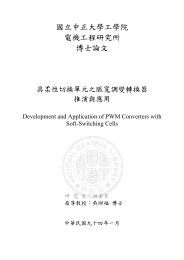Syntax of the Bi Comparative Construction in Mandarin Chinese
Syntax of the Bi Comparative Construction in Mandarin Chinese
Syntax of the Bi Comparative Construction in Mandarin Chinese
You also want an ePaper? Increase the reach of your titles
YUMPU automatically turns print PDFs into web optimized ePapers that Google loves.
<strong>Syntax</strong> <strong>of</strong> <strong>the</strong> <strong>Bi</strong> <strong>Comparative</strong> <strong>Construction</strong> <strong>in</strong> Mandar<strong>in</strong> Ch<strong>in</strong>ese<br />
Third, accord<strong>in</strong>g to <strong>the</strong> pragmatic pr<strong>in</strong>ciple, Li and Thompson (1981) try to make<br />
sentences (14) more clearly as (17b); yet it obeys <strong>the</strong>ir first hypo<strong>the</strong>sis that <strong>the</strong><br />
compared items should be <strong>the</strong> topic or subject, and <strong>the</strong> compared items X and Y are<br />
not constituents. Tsao attemps to account for <strong>the</strong>m by deletion rules.<br />
(17) a. wo bi zuotian shufu<br />
I COM yesterday comfortable<br />
‘I feel better than I did yesterday.’<br />
b. wo j<strong>in</strong>tian bi wo zuotian shufu<br />
I today COM I yesterday comfortable<br />
‘Same as (a).’<br />
In Tsao’s Topic-Comment analysis, he claims that <strong>the</strong> compared items which are<br />
on both sides <strong>of</strong> <strong>the</strong> comparative marker-bi should be topics <strong>of</strong> an equal rank- primary,<br />
secondary, or tertiary, which <strong>in</strong> order are given examples <strong>in</strong> (18), (19), and (20). And<br />
<strong>the</strong> compar<strong>in</strong>g dimension is expressed by <strong>the</strong> Comment part, which is ei<strong>the</strong>r an adverb<br />
or a verb capable <strong>of</strong> be<strong>in</strong>g modified by <strong>the</strong> adverb hen ‘very.’ The idea that <strong>the</strong><br />
compared topics can be <strong>of</strong> different rank gives an explanation to those compared<br />
items that are not full constituents such as (19) and (20).<br />
(18) ta bi wo nenggan (primary topics)<br />
s/he COM I competent<br />
‘S/He is more competent than I am.<br />
12<br />
中正大學 e-Thesys (94 學年度)





